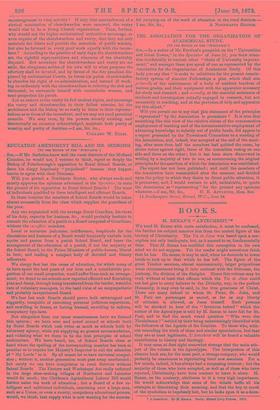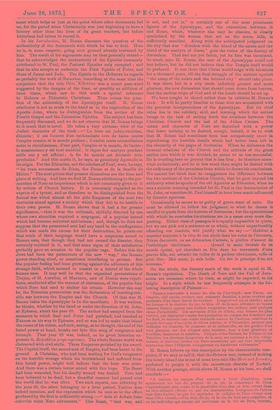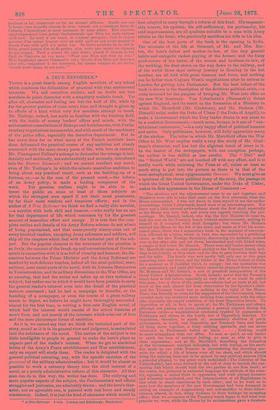BOOKS.
M. RERAN'S ANTECHRIST."* WE read M. Renan with more satisfaction, it must be confessed, the further his subject removes him from the central figure of the his tory of Christianity. The Vie de Jesus was based upon a con- ception not only inadequate, but, as it seemed to us, fundamentally false. That M. Renan has modified this conception in his own
mind we do not suppose. Yet the reader might sometimes think. that he has. He seems, it may be said, when he descends to lower- levels to look up to that which he has left. The figure of the-
great Teacher assumes, almost unconsciously, larger proportions. when circumstances bring it into contrast with the littleness, the-
jealousy, the division of the disciples. Hence this volume may be read, without at least that offence which the Vle de Jesus could not but give to every believer in the Divinity, nay, in the perfect Humanity, it may even be said, in the true greatness of Christ. There are many indeed to whom St. Peter, St. John, and St. Paul are personages as sacred, as far as any liberty- of criticism is allowed, as Jesus himself. Such persons. will be shocked to hear of the "ferocious hatred" which the-,
author of the Apocalypse is said by M. Renan to have felt for St- Paul, and to find the much vexed question "Who were the Nicolaitanes ?" settled by their being unhesitatingly identified with. the followers of the Apostle of the Gentiles. To those who, with- out conceding the truth of these and similar speculations, feel that they are at least legitimate, L'Antechrist will be found a valuable contribution to history and theology.
It may seem at first sight somewhat strange that the main sub- ject of the volume is the Apocalypse. The interpreters of this obscure book are, for the most part, a strange company, who would probably be unanimous in reprobating their new associate. For a few minds, indeed, it has always had a surpassing interest ; but the majority of those who have accepted, as well as of those who have rejected, Christianity, have been content to leave it alone. M. Renan, on the contrary, attributes to it a very high importance. He would acknowledge that some of the details baffle all his attempts at discovering their meaning, and that the key to much of the symbolism is hopelessly lost, but he looks upon it as a docu-
* L' Antechriat. By M. Renan. Paris: Michel Ldvy Frbres. 1878. cleat which helps us just at the point where other documents fail VS, for the period when Christianity was just beginning to have a history other than the lives of its great teachers, but before historians had arisen to record it.
In his Introduction, M. Renan discusses the question of the -authenticity of the documents with which he has to deal. Here he is, in some respects, going over ground already traversed by him. The result of his arguments may be thus generally stated— that he acknowledges the authenticity of the Epistles commonly -attributed to St. Paul, the Pastoral Epistles only excepted ; and that he also accepts as authentic the First Epistle of Peter, and those of James and Jude. The Epistle to the Hebrews he regards 48 probably the work of Barnabas, hazarding at the same time the conjecture that the title 11P6S 'Minden; was a secret pass-word suggested by the dangers of the time, or possibly an addition of later times, which saw in this work a special reference to Hebrew or Ebionistic Christians. Then comes the ques- tion of the authorship of the Apocalypse itself. M. Renan attributes it not so much to the hand as to the inspiration of the Apostle John, whom he distinguishes from the author of the Fourth Gospel and the Johannine Epistles. The subject has been frequently discussed, and we do not observe that M. Renan brings to it much that is novel. He takes a very extreme view of the -Judaic character of the book :—" Le livre est judeo-chretien, 4bionite ; II est l'ceuvre d'un enthousiaste ivre de haine contre lempire romain et le monde profane ; ii exclut toute reconciliation -entre le christianisme, d'une part, l'empire et le monde, de l'autre ; le messianisme y est tout material; le regne des martyrs pendant mile an.s y est affirme ; la fin du monde est declare() tres- prochaine." And this marks it, he says, as genuinely Apostolic in its origin. For the Ebionites, not the scholars of Paul, were, he says, " les vrais successeura de Jesus, des Douse et de la famille du Maitre." The next points that present themselves are the time and place of writing. And here we find M. Renan attributing to the per- secution of Nero an importance which is not commonly given to it by writers of Church history. It is commonly regarded as the caprice of a tyrant, and as therefore to be distinguished from the formal war which almost all the able Emperors of the next two centuries aimed against a society which they felt to be hostile to their own power. M. Renan shows that it had a far greater -significance,—that it was the outbreak, skilfully directed by one whose own atrocities required a scapegoat, of a popular hatred which had become universal and intense ; and, though he does not :suppose that the persecuted sect had any hand in the conflagration which was made the excuse for their destruction, he points out that much of their language would have a suspicious sound to Roman ears, that though they had not caused the disaster, they certainly rejoiced in it, and that some signs of their satisfaction probably gave an occasion to the popular rage. Before this the Jews had been the persecutors of the new "way," the Roman power standing aloof, or sometimes interfering to protect. But the popular feeling had been growing against the adherents of this -strange faith, which seemed to consist in a hatred of the whole lumen race. It may well be that the organised persecutions of "Trajan, of M. Aurelius, of Maximin, and of Decius were repeti- tions, conducted after the manner of statesmen, of the popular fury 'which Nero had used to shelter his crimes. However this may be, the Neronian persecution was the declaration of inextinguish- able war between the Empire and the Church. Of that war M. Renan takes the Apocalypse to be the manifesto. It was written, he thinks, whether by the hand or under the direction of St. John, At Ephesus, about the year 69. The author had escaped from the massacre in which Saul and Peter had perished, had touched at 1Patmos on his way to Ephesus, and so was led to make that island the scene of his vision, and now, seeing, as he thought, the end of the hated power at hand, breaks out into this song of vengeance and 'triumph. That year 69 was, indeed, as its great historian ex- presses it, Reipublicx prope suprensus. The whole Roman world was -distracted with civil strife. Three Emperors perished by the sword. 'The Capitol itself, the sacred seat of Empire, had been burnt to the :ground. A Christian, who had been waiting for God's vengeance -on the horrible wrongs which his brotherhood had suffered from this hated power, might well believe that the hour was come. And there was a certain terror mixed with this hope. The Beast had been wounded, but his deadly wound was healed. Nero had been believed to be dead, but a dreadful rumour had passed over the world that he was alive. Two such reports, one referring to -the year 69, the other belonging to a later period, Tacitus does indeed mention, and the expression which he uses as to the effect produced by the first is sufficiently strong :—" Asia et Achaia falso .exterritx velut Nero adventaret." This Beast, "that was, and
is not, and yet is," is certainly one of the most prominent figures of the Apocalypse, and the connection between it and Rome, which, whatever else may be obscure, is clearly symbolised by the women that sat on the seven hills, is sufficiently manifest. Along with the anticipated judgment on the city that was "drunken with the blood of the saints and the blood of the martyrs of Jesus," goes the vision of the destiny of Jerusalem. That had not yet fallen, yet its fate was imminent. So much, says M. Renan, the seer of the Apocalypse could not but believe, but he did not believe that the Temple itself would be profaned. It was there that Christ would reign with his saints for a thousand years, till the final struggle of the nations against "the camp of the saints and the beloved city" should take place. It was there, but in a city made infinitely greater and more glorious, the new Jerusalem that should come down from heaven, that the endless reign of God and of the Lamb should be set up.
We have sought to sketch rather than to criticise M. Renan's view. It will be partly familiar to those who are acquainted with the preterist interpretations of the Apocalypse. But its chief value lies in the subtlety, skill, and learning which the author brings to the task of setting forth the relations between the Christian Church and the last of the Julian Cmaars. The career and character of Nero are described with a power that leave nothing to be desired, except, indeed, it be to wish that M. Renal' had sometimes been less scrupulously exact in reproducing the horrible details which had better been left in the obscurity of the pages of Suetonius. When he delineates the internal relations of the Church and the attitude of the great parties into which it was divided, he seems to us less successful. He is treading here on ground that is less firm ; he theorises some- what audaciously, and he is less exact than might be desired with the sufficiency of the premisses from which he draws his conclusions. We cannot but think that he exaggerates the difference between the two sections of the Christian Church, that he goes beyond his authority when he speaks of the old Apostles as Ebionites, when he sees a sinister meaning intended for St. Paul in the denunciation of
St. John, or considers St. Paul himself to have been much influenced by Gnostic opinions.
Occasionally he seems to us guilty of grave want of taste. He must be allowed to follow his judgment in what he deems it needful to quote from the horrors of Suetonius ; but the speculations with which he concludes his citations are in a sense even more dis- gusting. Either class of passages it is equally impossible to quote, but we can pick out a sentence or so which, without unpardonably offending our readers, will justify what we say :—" Habitué a marcher toujours h. la tete de son siècle dans lea voice de l'inconnu, Neron decouvrit, en sea debauches d'artiste, le philtre d'amour de reathetique chretienne Quand Is main brutale de ce monde epaise, qui cherchait ea fête dans lea tourments d'une pauvre ffile, cut arrache lea voiles de in pudeur chretienne, celle-ci pent dire : Moi aussi, je Buis belle. Ce fat is principe d'un art nouveau."
On the whole, the literary merit of the work is equal to M. Renan's reputation. The Death of Nero and the Fall of Jeru- salem are occasions where he rises, as might be expected, to his height. In a style which he leas frequently attempts is the fol- lowing description of Patmos:—
"Patmos reasonable it toutes lea ilea de l'Archipel: met d'azur' air limpide, eiel serein, rochers aux sommets dentate;, peine revetns par moments d'un leger duvet do verdure. L'aspect est nu et sterile; • main lea formes at la couleur du roc, le bleu vu f de la mar, sillonnee de beaux oiseaux blames, oppose aux teintes rougeatres des rochers, sent pelvis chose d'admirable. Ces myriades d'iles at d'ilots, aux formes lea plus variees, qui emergent comma des pyramides ou comma des boueliers stir lea iota, et dansent une rondo eternelle autour de rhorizon, sembient le monde feerique d'un cycle de dieux marina at d'Oceanides, menant nne brillante vie d'amour, de jounesse et de melancolie, an des grottes d'un vert glauque, stir des rivages sans mystere, tour it tour gracieux et terribles, lumineux et sombres. Calypso atlas Sirenes, lea Tritons et lea Nereides, lea charmes dangereux de is mer, ERB caresses a la fois volup- tueuses at sinistres, tontes cog fines sensations qui out lour inimitable expression dans l'Odyssie, echapperent an tenebreux visionnaire."
M. Renan follows up this description by the characteristic com- plaint, if we may so call it, that the Hebrew seer, instead of making
this lovely island the scene of some love-tale like Hero and Leander, preferred to people it with the monstrous cherubs of Ezekiel.
With another passage, which shows M. Renan at his best, we shall conclude :—
"A travers lea nuages d'un univers a retat d'embryon, notus apercevons lea lois du progrea de la vie, la conscience de retro s'agrandissant sans cease, at is possibilite d'un etat on tons seront dans un etre definitif (Dieu) co quo lea innombrables bourgeons de rarbre sont dans rarbre, ce qua lea myriades de cellules de l'etre vivant sent dans l'etre vivant,—d'un &at, dis-jo, oa la vie du tout sera complete, et
oil lea individns qui anront ete revivront en la vie de Dion, verrmt,
joniront en lui, chanteront en lui un &erne] Alleluia. Quelle quo colt la forme sous laquelle chacun de nous concoit cet avenement futur de l'absolu, l'Apocalypse no pout manquer de nous plairo. Elle exprime symboliquement cette pensee fondamentale quo Dieu eat, male surtout qu'il sera. Le trait y oat lourd, le contour mesquin ; c'est le crayon
grossier d'un enfant tracant area un outil ne salt point mauler le dessin d'une villa n'a point rue. Sa naive peinture de la cite do Dieu, grand joujou d'or et de perles, n'en rests pas moms un element de nos songes. Paul a mieux dit sans dente, quaml il resume le but final de l'univers en ces mote: "Pour quo Dieu colt tout en tons." Mais longtemps encore l'humanite aura besoin d'un Dieu (pi demeure area elle, compatisse h ses eprenves, lui tienne compte do sea luttes, essuie toute larme do sea yens.'"




































 Previous page
Previous page